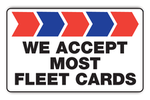So winter has arrived and you don't feel confident in how your 2-wheel drive vehicle does in the snow and ice. You envy all those people with all-wheel-drive (AWD) and 4-wheel-drive (4WD) cars, trucks and SUVs. You start thinking, "I need one of those. I'll be able to go anywhere without any worries." The truth is there might be another option for you that you might not have thought of.
Sure, you've seen the ads that tout the advantages of AWD and 4WD, and some of the videos make it look like they can handle everything Mother Nature can throw their way. The truth, though, is that vehicles with drive wheels at all four corners can't stop any more quickly than those with 2-wheel-drive. Yes, AWD and 4WD vehicle have advantages when it comes to acceleration, but when it comes to stopping and handling, they generally don't.
If you buy a new AWD or 4WD vehicle, you are going to spend thousands of dollars. Maintenance and upkeep costs are higher due to the vehicle's increased complexity and weight, and you're likely to take a hit in fuel economy. So, what's the option we mentioned above? It's simple. Winter tires.
If you have a front-wheel-drive (FWD) vehicle with winter tires, you'll notice a tremendous difference in your winter traction and stopping than the all-season tires that are on most vehicles. One tire company, Michelin, wanted to find out which was better in the snow: an AWD car with all-season tires or a FWD car with winter tires. And they found while the AWD car could get going a little more easily, in most of the other comparisons, the FWD car with winter tires handled equally or better and stopped in a shorter distance. The optimal combination would be, of course, AWD or 4WD with winter tires. But one major consumer testing magazine found that only about 12 percent of their subscribers who drove AWD or 4WD vehicle in the snow for more than 6 days in the previous winter even used winter tires!
So a set of winter tires may give you the handling and stopping you're looking for and for a lot less cash than a new AWD vehicle. Consult your service advisor for some recommendations. You may be pleasantly surprised at how you can handle winter roads without having to handle a new, big, fat monthly payment for a new vehicle.
Tuffy North Clermont
1315 E. Highway 50
Clermont, Florida 34711
(352) 241-9466
https://www.tuffynorthclermont.com/
 Win a $50 Gas Card
Learn more
Win a $50 Gas Card
Learn more
 Sign up texting for $8 OFF Any Oil Change
Learn more
Sign up texting for $8 OFF Any Oil Change
Learn more
 Have a promo code?
Have a promo code? Sign up and start Saving.
Learn more
Sign up and start Saving.
Learn more
 Win a $50 Gas Card
Learn more
Win a $50 Gas Card
Learn more
 Sign up texting for $8 OFF Any Oil Change
Learn more
Sign up texting for $8 OFF Any Oil Change
Learn more
 Have a promo code?
Have a promo code? Sign up and start Saving.
Learn more
Sign up and start Saving.
Learn more

















